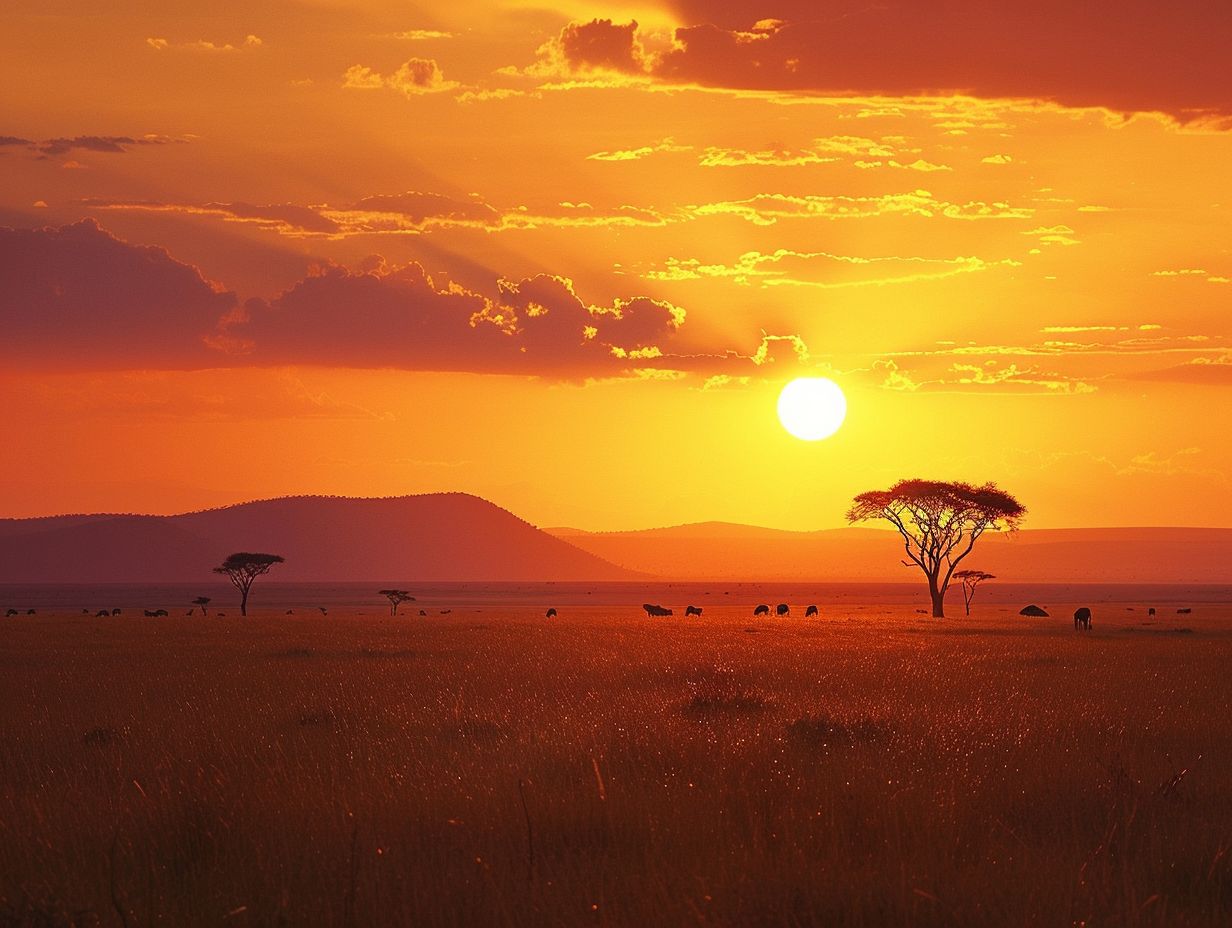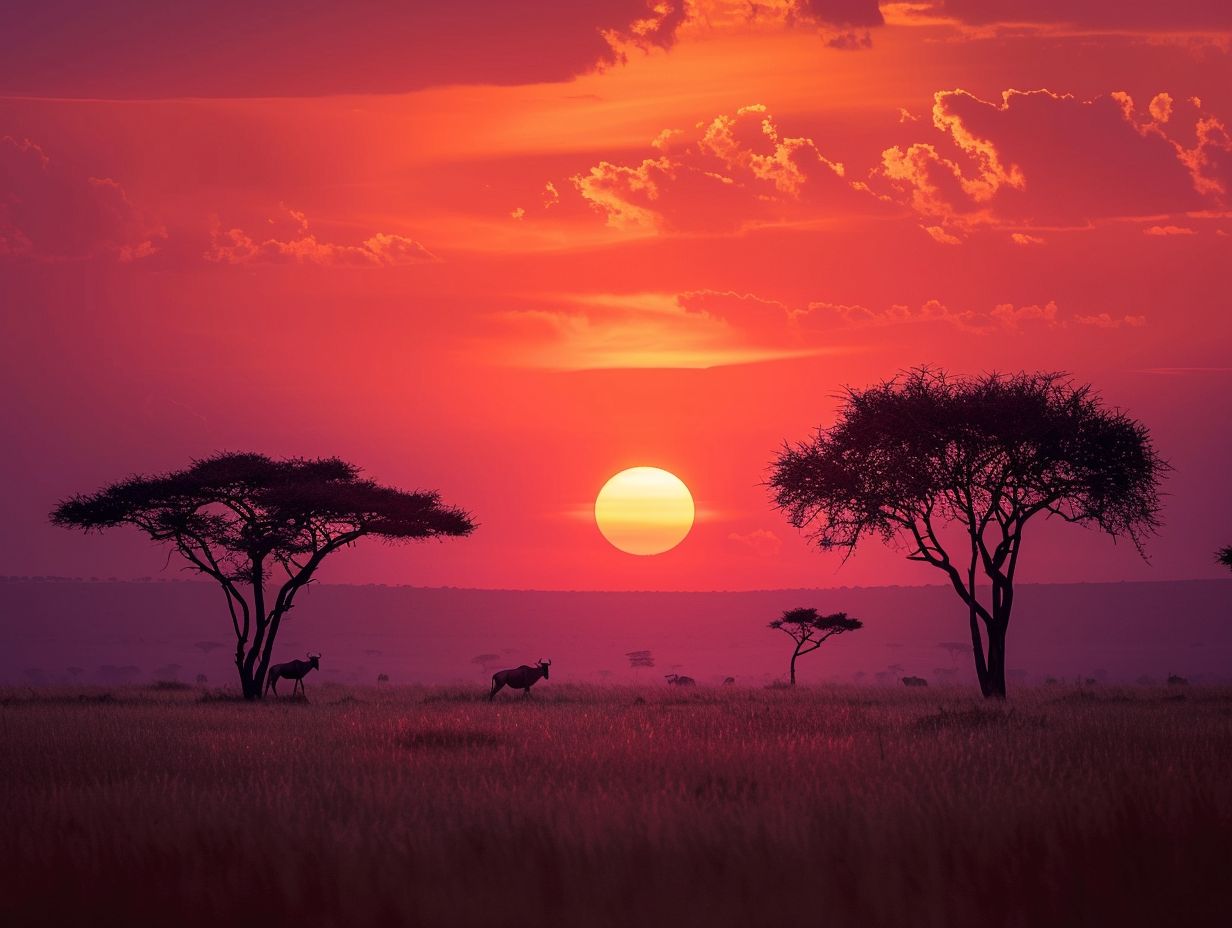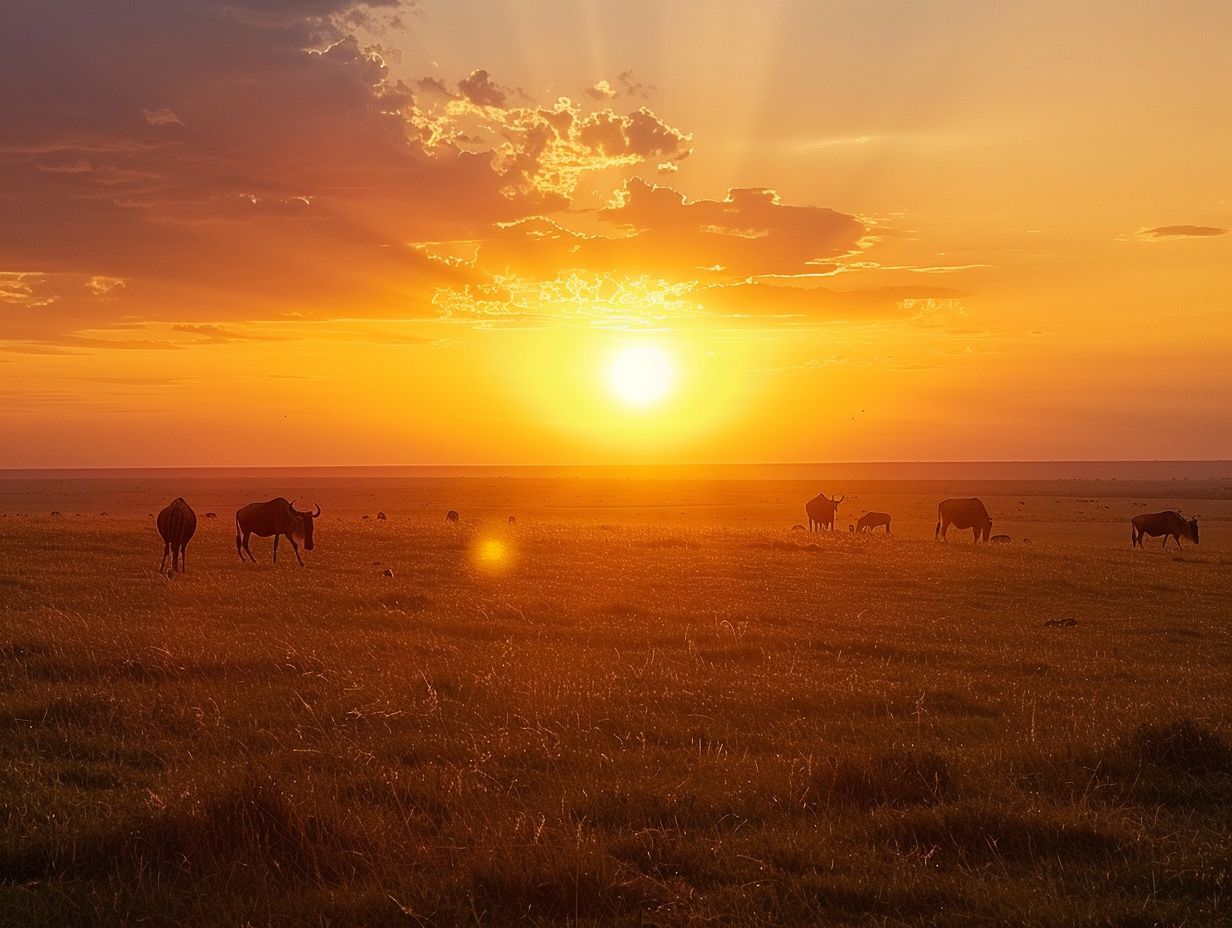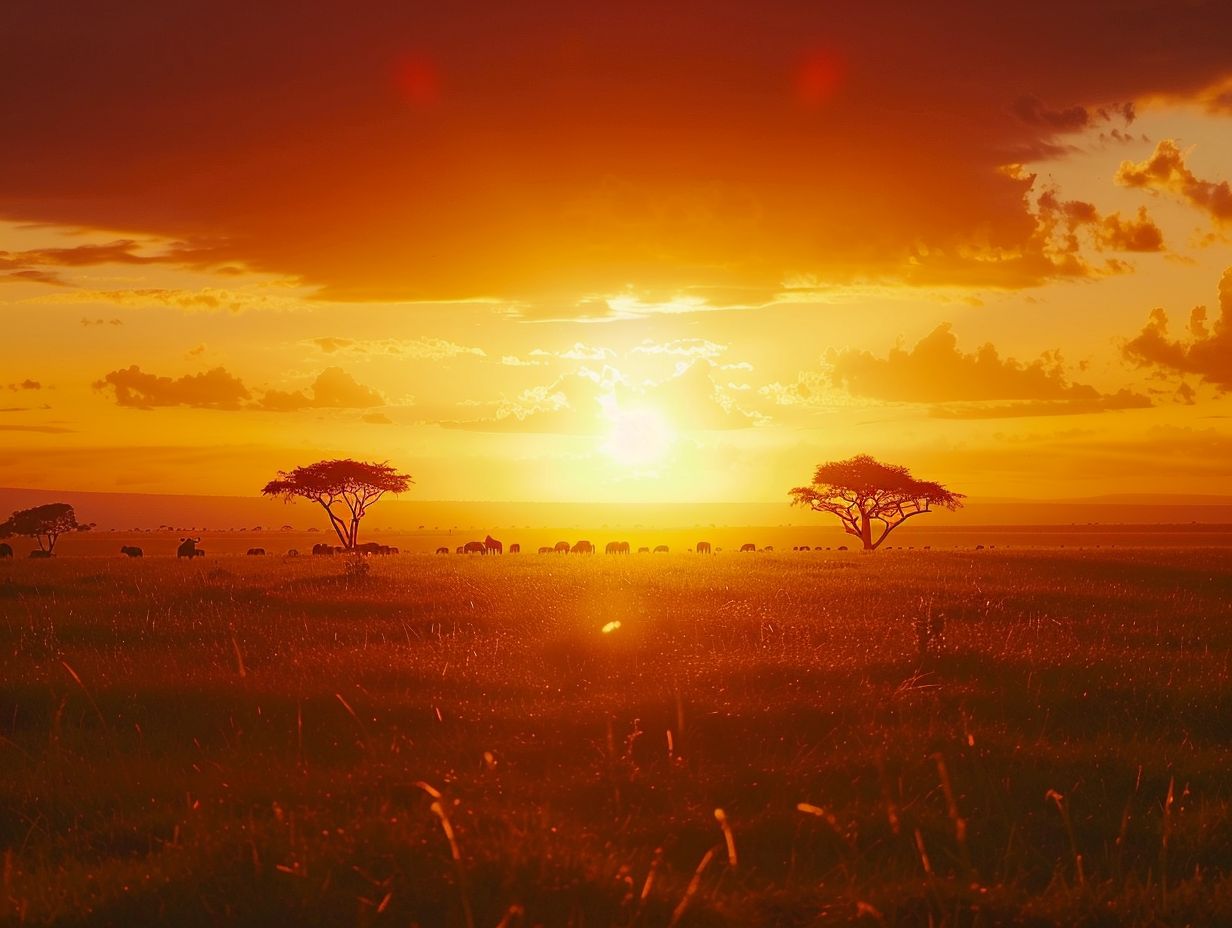
Best Time To Visit Serengeti
Planning a safari to Serengeti National Park? Choosing the best time to visit is crucial for an unforgettable experience.
We will explore the factors to consider when deciding between the dry and wet seasons in Serengeti. From weather conditions to the advantages and disadvantages of each season, we will help you make an informed decision.
Discover the highly anticipated Great Migration season and other factors to consider when planning your trip. Get valuable insights to make the most of your Serengeti adventure!
Key Takeaways:

- The best time to visit Serengeti is during the dry season (June-October) or the migration season (December-March).
- The dry season offers ideal weather conditions for game viewing, while the migration season allows for a chance to witness the Great Migration.
- Personal preferences, availability of accommodations, and tour packages should also be considered when choosing the best time to visit Serengeti.
What is the Best Time to Visit Serengeti?
Determining the best time to visit Serengeti National Park depends on several factors, including wildlife viewing opportunities, weather conditions, and peak visitor seasons.
One of the primary considerations when planning a trip to this renowned park is the Great Migration, a spectacular natural event where millions of wildebeest and zebra traverse the plains in search of water and fresh grazing. This migration typically occurs from late May to early July and from late October to December, making these periods the best times to witness this awe-inspiring sight.
The dry season between June and September is ideal for game viewing as animals congregate around water sources, offering excellent opportunities to observe the diverse wildlife in their natural habitat. Avoiding the rainy season from March to May is advisable, as the heavy downpours can make the roads impassable and limit visibility.
Understanding the peak visitor seasons is crucial to ensure a more enjoyable and less crowded experience. The months of June to August and December to February are popular among tourists, so planning your visit during the shoulder seasons like March to May or September to November can provide a more serene and intimate safari experience.
Aside from wildlife, Serengeti National Park boasts iconic landmarks such as the vast plains of the Serengeti, the stunning Ngorongoro Crater, and the picturesque Grumeti River. Exploring these attractions can enhance your overall safari experience, making your visit to the Serengeti National Park truly unforgettable.
Factors to Consider for Best Time to Visit Serengeti:
When planning your visit to Serengeti National Park, consider key factors like the Great Migration action, optimal wildlife viewing opportunities, accommodation rates, and strategies for avoiding tourist crowds.
Understanding the movement of the Great Migration is crucial when determining the best time to visit Serengeti. The annual migration of millions of wildebeest and other animals between Serengeti and Maasai Mara is a spectacular sight that draws large crowds. Optimal wildlife viewing opportunities are often tied to the timing of this migration, offering unparalleled chances to see predators in action.
Next, accommodation rates can greatly impact your travel budget. Peak seasons see higher prices and greater demand, while off-peak times may offer discounted rates. It’s essential to research and book accommodations in advance to secure competitive prices.
To avoid overcrowding at popular wildlife spots, consider visiting during shoulder seasons or less busy months. Early mornings and late afternoons usually present fewer tourists, providing a more intimate and peaceful wildlife experience.
1. Dry Season in Serengeti:
The dry season in Serengeti National Park offers unique opportunities for safari enthusiasts to witness diverse wildlife encounters amidst the arid landscape.
The dry season in Serengeti typically spans from June to October, characterized by minimal rainfall and sunny days. With the absence of heavy downpours, the landscape transforms into an open savannah dotted with acacia trees.
Visiting during this period not only ensures clear visibility for game viewing but also increases the chances of witnessing incredible wildlife spectacles like the Great Migration, where vast herds of wildebeest and zebras traverse the plains in search of fresh grazing grounds.
Safari tours during the dry season offer an unparalleled experience of tracking the Big Five – lions, elephants, buffalos, leopards, and rhinos – as they congregate around watering holes and riverbanks, providing excellent photo opportunities.
-
What Months are Considered the Dry Season?
The dry season in Serengeti typically falls between June and October when the region experiences minimal rainfall, providing an ideal environment for diverse wildlife species and safari vehicles to traverse the terrain.
During these months, the climate in Serengeti transforms into a dry and dusty landscape, with clear blue skies and warm temperatures during the day. These arid conditions make it easier for safari-goers to spot a vast array of animals congregating around the limited water sources.
The lack of foliage due to the dry season allows for unobstructed views of the wildlife, enhancing the overall safari experience. Safari vehicles can navigate the terrain more freely without the hindrance of muddy tracks, offering visitors ample opportunities for close encounters with the magnificent creatures that call Serengeti home.
-
What are the Weather Conditions during the Dry Season?
During the dry season in Serengeti, the weather is characterized by clear skies, minimal precipitation, and heightened predator action, creating ideal conditions for witnessing thrilling river crossings and wildlife interactions.
The dry season in Serengeti, which usually spans from June to October, showcases vast plains with a golden hue under the scorching sun, making wildlife more concentrated around the water sources such as the Grumeti and Mara rivers.
With limited vegetation cover, predators like lions, leopards, and cheetahs are easily spotted, increasing the chances of witnessing a hunt or intense predator-prey interactions.
This arid climate also prompts the massive wildebeest migration, offering visitors a front-row seat to the dramatic river crossings as the herds navigate through crocodile-infested waters in search of greener pastures.
-
What are the Pros and Cons of Visiting Serengeti during the Dry Season?

Visiting Serengeti during the dry season, while popular due to prime wildlife viewing conditions, also comes with considerations such as peak visitor numbers and higher accommodation rates.
Opting to travel to the Serengeti during the dry season offers unparalleled opportunities to witness the diverse array of animals congregating around water sources, making it a unique and rewarding experience for wildlife enthusiasts. The sparse vegetation allows for easier sightings, enhancing the chances of spotting elusive species like lions, leopards, and cheetahs in action.
Despite these advantages, one must be prepared for the influx of safari-goers flocking to the park during this period. The increased tourist traffic can sometimes detract from the sense of wilderness and tranquility one seeks in such a remote location. The heightened demand for accommodations often leads to booking challenges and higher prices, requiring travelers to plan and secure their stays well in advance.
2. Wet Season in Serengeti:
The wet season in Serengeti National Park transforms the landscape into a lush paradise, offering unique opportunities for witnessing river crossings and intimate wildlife encounters.
Spanning from March to May, the wet season in Serengeti brings refreshing rainfall that rejuvenates the vegetation, turning the plains into a vibrant green carpet dotted with colorful flowers.
The increased water availability sustains a variety of wildlife species, attracting herds of zebras, wildebeests, and antelopes, creating a spectacle as they navigate the swollen rivers during their annual migration. The lush surroundings provide ample grazing opportunities for herbivores, which, in turn, draw predators, offering a chance to witness thrilling hunting scenes.
-
What Months are Considered the Wet Season?
The wet season in Serengeti typically occurs from November to May, marked by increased rainfall and a dynamic shift in wildlife behavior, including migration action and lush greenery.
November to May in Serengeti witnesses a remarkable transformation in the landscape and behavior of the wildlife. The arrival of rain rejuvenates the arid land, turning it into a lush green paradise that sustains a myriad of plant and animal life.
The increased rainfall acts as a catalyst for the Great Migration, where millions of wildebeests, zebras, and antelopes embark on their iconic journey in search of fresh grazing grounds.
-
What are the Weather Conditions during the Wet Season?
The wet season in Serengeti brings abundant rainfall, fostering lush vegetation that attracts diverse wildlife species such as cheetahs and crocodiles, enhancing the safari experience with unique viewing opportunities.
During this time, the landscape transforms into a vibrant tapestry of green, dotted with colorful flowers that bloom under the nourishing rain. The water sources swell, creating ideal habitats for hippos, elephants, and a myriad of bird species. The increased vegetation also leads to more herbivores like zebras and wildebeests roaming the plains in search of fresh pastures.
-
What are the Pros and Cons of Visiting Serengeti during the Wet Season?
Exploring Serengeti during the wet season offers the chance to witness dramatic river crossings and heightened predator action, showcasing a different facet of the seasonal Serengeti experience.
During this time, the Serengeti transforms into a lush paradise with vibrant green landscapes and an abundance of wildlife attracted by the blooming vegetation. The spectacle of animals migrating across the rivers is a thrilling sight, with wildebeests and zebras attempting treacherous crossings while evading hungry crocodiles lurking in the waters.
Witnessing the intense interaction between predator and prey is both exhilarating and educational, providing a closer look at the delicate balance of nature and the survival strategies of the animals. The wet season also brings challenges such as muddy roads that can make transportation more difficult, and the increased vegetation may obstruct visibility of wildlife in certain areas.
3. Migration Season in Serengeti:
The migration season in Serengeti is a spectacle to behold, characterized by the iconic Great Migration of wildebeest and zebras, offering unforgettable encounters with wildlife and mesmerizing river crossings.
During this time, the vast plains of Serengeti come alive with thousands of animals on the move, following ancient migratory routes in search of fresh grazing pastures.
Guided by their instincts, the herds embark on a perilous journey, braving predators and obstacles along the way. Safari vehicles play a crucial role in tracking these movements, allowing visitors to witness this natural spectacle up close.
One of the most thrilling experiences is witnessing the wildebeests as they gather courage and make daring river crossings, facing crocodile-infested waters in their quest for survival.
-
When Does the Great Migration Occur?

The Great Migration typically transpires from June to August, as vast herds of wildebeest and zebras traverse the Mara Serengeti region, navigating treacherous river crossings teeming with crocs and challenging rapids.
During September to November, the journey continues as the herds move towards the southern Serengeti plains, where the nutrient-rich grasslands beckon. These months witness the iconic river crossings at Grumeti River, presenting another hurdle with its strong currents and lurking crocodiles.
In December to March, the migration shifts to the eastern and southeastern Serengeti, with the herds spread across the vast plains and calving their young. The predators eagerly await this vulnerable time, preying on the newborns amidst the chaos.
By April and May, the cycle repeats as the rains prompt the herds to head north once more, braving the perilous Mara River crossings at the northern Serengeti, where the drama of survival unfolds amid the swirling waters and waiting predators.
-
What are the Benefits of Visiting Serengeti during Migration Season?
Journeying to Serengeti during migration season promises unparalleled opportunities to witness a diverse array of wildlife species, thrilling predator action, and the mesmerizing spectacle of vast herds on the move.
One of the standout advantages of visiting Serengeti during this period is the dynamic predator-prey interactions that unfold as the migrating herds attract predators such as lions, cheetahs, and hyenas.
The sheer scale of the movements of wildebeest, zebra, and gazelles creates a thrilling backdrop to observe the circle of life in action, as survival instincts and hunting strategies play out in real time.
The immersive experiences during the migration season offer a deep connection to the natural world, with opportunities to witness the resilience and adaptability of both predators and prey in the wild.
-
What are the Challenges of Visiting Serengeti during Migration Season?
Traveling to Serengeti during migration season presents challenges such as increased tourist traffic, fluctuating weather conditions, and the need for well-planned safari tours to navigate the dynamic landscapes of the wet season.
One major obstacle visitors face during the migration season in Serengeti is managing the sheer number of tourists who flock to witness this incredible natural phenomenon. With the influx of people, it’s crucial to find ways to appreciate the wildlife and landscapes while avoiding overcrowding and preserving the sense of wilderness.
The unpredictable weather patterns in the region can make planning difficult, as rains can alter the animals’ movements and the overall safari experience. Structured safari tours play a vital role in providing a seamless and optimized exploration of the diverse habitats, ensuring that visitors make the most of their time amidst the wonders of Serengeti.
Other Factors to Consider for Best Time to Visit Serengeti:
Beyond seasonal considerations, factors like accommodation availability, personal preferences, and the allure of specific tourist attractions play a crucial role in determining the ideal time to visit Serengeti National Park.
When planning a trip to Serengeti, it’s essential to take into account the range of accommodations available in and around the park. From luxurious lodges to cozy tented camps, visitors can choose the type of stay that best suits their comfort and budget. Accommodation options can vary in availability depending on the time of year, with peak seasons often experiencing higher demand.
Aligning your travel preferences with the seasonal variations can greatly enhance your overall experience. Whether you prefer witnessing the great migration, enjoying optimal game viewing, or simply basking in the serene beauty of the landscape, different times of the year offer unique opportunities.
-
Availability of Accommodations and Tour Packages:
Understanding the availability of accommodations and tour packages in Serengeti is essential for planning a seamless safari experience, with considerations like accommodation rates impacting the overall travel budget and safari itinerary.
Choosing the right accommodation option can significantly enhance your experience in the Serengeti. The accommodation rates play a crucial role in determining where you stay and for how long.
Opting for structured safari itineraries can streamline your journey, ensuring you make the most of your time observing the majestic wildlife. Serengeti offers an array of lodging choices to suit diverse preferences, from luxurious lodges with stunning views to unique lion-themed accommodations that bring you closer to the heart of the wild.
-
Personal Preferences and Interests:
Tailoring your Serengeti journey to align with personal preferences and interests allows for a more customized safari experience, whether you seek intimate wildlife encounters, thrilling safari adventures, or specific encounters with Africa’s big cats.
Delving into the realm of the Serengeti unveils a vast landscape teeming with diverse wildlife species, from the graceful gazelles to the majestic elephants roaming freely. The opportunity to witness the iconic wildebeest migration, one of nature’s most breathtaking spectacles, is a highlight that appeals to many safari enthusiasts.
For adrenaline seekers, the Serengeti offers exhilarating game drives and bush walks, allowing you to immerse yourself in the raw beauty of the African wilderness. The thrill of tracking lions or leopards through the savannah adds an element of excitement and unpredictability to your safari.
Conclusion:

A visit to Serengeti National Park promises unparalleled wildlife encounters, captivating safari tours, and the awe-inspiring spectacle of the Great Migration, showcasing the rich biodiversity and natural wonders of this iconic destination.
Visitors to Serengeti can witness a breathtaking array of wildlife, from majestic lions and graceful giraffes to elusive leopards and massive herds of elephants roaming freely in their natural habitat. The immersive safari tours offer close-up views of these incredible creatures in action, providing a deep connection to the untamed beauty of the wild.
One of the greatest draws of Serengeti is the Great Migration, where millions of wildebeests, zebras, and other herbivores traverse the plains in search of fresh grazing lands. This epic phenomenon not only showcases the resilience and harmony of nature but also offers a once-in-a-lifetime opportunity to witness this dramatic spectacle up close.
The park boasts a diverse range of wildlife species, including the endangered black rhinos, elegant cheetahs effortlessly sprinting across the savannah, and the comical antics of playful monkeys swinging through the trees. Each encounter with these remarkable creatures brings a deeper appreciation for the intricate ecosystem that thrives within the heart of Serengeti.
Frequently Asked Questions:
1. What is the best time to visit Serengeti?
A: The best time to visit Serengeti is during the dry season, which is from late June to October. This is when the wildlife congregates around water sources, making it easier to spot them and witness the great wildebeest migration.
2. What are the advantages of visiting Serengeti during the dry season?
A: Visiting Serengeti during the dry season has many advantages. The weather is pleasant and there is less chance of rain, which makes for enjoyable game drives. The wildlife is also easier to spot as they gather around the water sources, and the great wildebeest migration takes place during this time.
3. Is it possible to visit Serengeti during the rainy season?
A: Yes, it is possible to visit Serengeti during the rainy season, which is from November to May. However, the roads may become impassable and the wildlife may be more dispersed due to the abundance of water sources. It is also the low season, meaning fewer crowds and potentially lower prices.
4. What is the best time to witness the great wildebeest migration in Serengeti?
A: The best time to witness the great wildebeest migration in Serengeti is from late June to October. During this time, the wildebeest, zebra, and gazelle make their annual journey from the Serengeti to the Masai Mara in search of greener pastures.
5. Can I visit Serengeti at any time of the year?
A: Yes, Serengeti is open for visitors all year round. However, the dry season is the best time to visit for optimal wildlife viewing. The rainy season may also offer unique experiences, such as the birth of baby animals.
6. What is the weather like in Serengeti?
A: The weather in Serengeti is generally hot and dry during the day and cool at night. During the dry season, temperatures can reach up to 90°F (32°C), while the rainy season is slightly cooler with temperatures averaging around 77°F (25°C). It is important to pack appropriate clothing for both hot and cooler weather conditions.